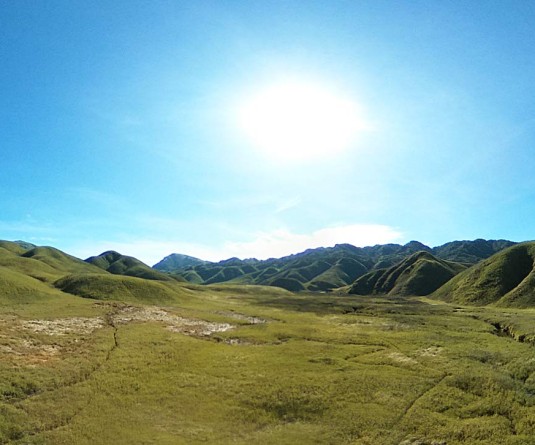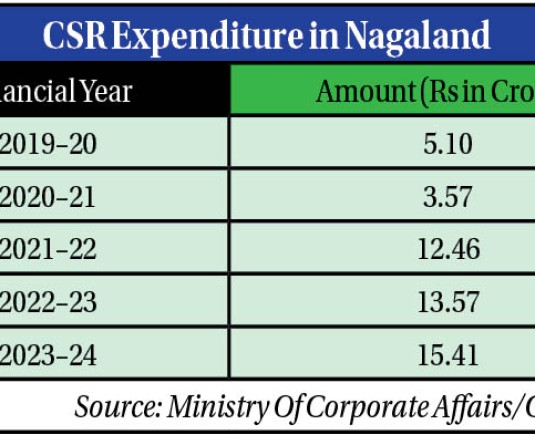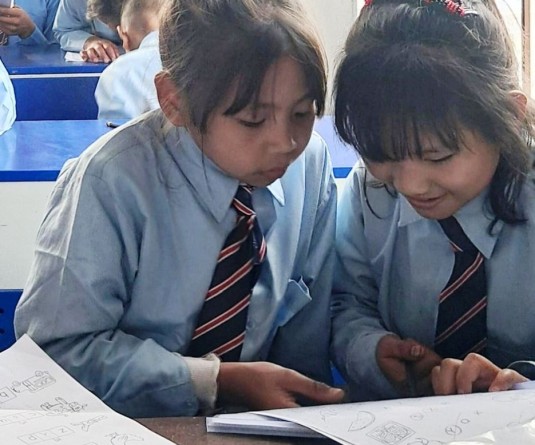Young oak and fruit trees grow in a rejuvenated jhum field in Gariphema, a model for ecologically sound shifting cultivation. (Photo Courtesy: FOCUS-IFAD project)

Morung Express News
Kohima | June 19
Located about 50 kilometers from Kohima lies Gariphema village where the Angami and Sema tribes have lived in harmony for generations. Here, conversations flow in both dialects fluently where farming in the heartbeat of the village economy with 90% of the population engaged in farming activities.
And unbeknownst to many, with a population of just 1,600, Gariphema village is leading the way by rewriting the landscape of jhum cultivation by incorporating innovation to tradition form of farming.
A farmer for as long as he can remember, Pukhato Kire, a key functionary of the Dzuu Food Producer Organisations (FPOs) speaking to The Morung Express said there has been numerous changes in the landscape of jhum cultivation in Gariphema village in the past few years.

With the intervention of the FOCUS-IFAD project that support farmers through Centrally Sponsored Schemes and External Aided projects, Kire said, it has given the farmers a new direction which is beneficial to the farmers as well regenerating nature while being rooted to the local traditions and practices.
It may be mentioned that the objective of the intervention of the FOCUS-IFAD project is to regenerate fallow Jhum fields through ecologically sound practices, enhance forest cover and promote sustainable land and forest management and integrate modern farming approaches with traditional knowledge for increased environmental sustainability and farm profitability.
Journey to jhum rejuvenation
Kire recalled that earlier the primary focus of the farmers were solely on plantation of rice, which requires laborious physical works, and often, the harvest could hardly last a year for the family with no additional income from the fields.
However, in the past few years, he narrated how the farmers in his village are getting surplus income by practising mixed cropping of vegetation alongside rice.

When asked as to how the jhum regeneration is practice in the village, Kire said, following the cutting, burning and cleaning, the farmers plant fruits and oak trees in the fields as introduced and was whole-heartedly accepted by the farmers.
As per an official from the FOCUS-IFAD project, in 2020, thirty-one Jhumia households were introduced to an innovative approach called “Green Jhum” integrating the cultivation of socially accepted, fast-growing, high-value trees during the active Jhum cycle itself.
Accordingly, Oak trees, native to the region and valued for their high calorific fuelwood, were introduced directly into cultivated Jhum fields rather than during the fallow phase. Each family received 2 kilograms of Oak (Quercusserrata) seeds covering a total of 12.4 hectares (0.4 Ha per household). Bamboo markers were used to identify and safeguard emerging seedlings, and as the Jhum cycle ended, targeted cleaning during the monsoon and post-monsoon periods further encouraged the saplings' development during fallow.

Kire also informed that since the intervention programme, some oak trees have reached the heights of 10–15 feet rejuvenating the degraded fallow lands.
A farmer’s journey of transformation
Mhalelie Lohe, a farmer from Gariphema has emerged as a progressive mode farmer who has transformed his rejuvenated jhum land into small, yet thriving mini Integrated Farming System (IFS).
He grows winter vegetables, bananas, lemons, and even coffee, and also raises goats, ducks, and indigenous poultry. Lohe has also planted windbreak trees and more Oak, dug contour trenches to preserve soil, and constructed a Jalkund, a rainwater harvesting pond that holds 13,000 liters of water.

Seeds of unity
What makes Gariphema’s story even more remarkable is the collective spirit of the community. As Pukhato Kire, puts it “it is our unity and camaraderie that makes this work. We don’t just plant seeds, we are planting hope together.”
This year, he said, the villagers have come together to plant over 4,000 kilograms of ginger, a testimony to their growing confidence and the strength of their evolving farming systems.

Farming, once considered as a profession for the villagers or illiterate, is now slowly evolving into a dynamic sustainable livelihood for all, as according to Kire, the villagers of Gariphema with 314 households – both young and old, educated and uneducated are enthusiastically engaged in farming activities.
Besides, he proudly says that Gariphema has a single Church denomination, the Nagaland Christian Revival Church (NCRC) which was said, to have originated in the village in 1962.
With its success story, today Gariphema village stands as a model on how indigenous knowledge and modern interventions can come together for a sustainable future, and how the most powerful transformations begin with a single seed, and a community willing to nurture it.






